 |
 by Vincent van Gogh |
 |
 |
 by Vincent van Gogh |
 |
VINCENT WILLEM VAN GOGH is generally considered the greatest Dutch painter after Rembrandt, and one of the greatest of the Post-Impressionists. He powerfully influenced the current of Expressionism in modern art. His work, all of it produced during a period of only 10 years, hauntingly conveys through its striking
color, emphatic brushwork, and contoured forms his keen observations of nature (see photograph) and the anguish of a mental illness that eventually resulted in suicide. His artistic career was extremely short, lasting only the 10 years from 1880 to 1890.
In his pictures he strove to respect the external, visual aspect of a figure or landscape but found himself unable to suppress his own feelings about the subject. These found expression in emphatic contours and heightened effects of
color.
Tip:
Please point the stamps with the mouse index for more information about
the works of art displayed.
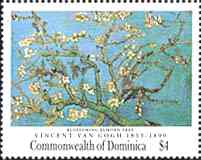 |
 |
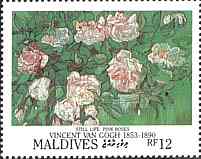 |
 |
Van Gogh's pictorial style was not calculated, however, but spontaneous and instinctive, for he worked with great speed and intensity, determined to capture an effect or a mood while it possessed him. His Arles subjects include blossoming fruit trees, views of the town and surroundings, self-portraits, portraits of Roulin the postman and other friends, interiors and exteriors of the house, a series of sunflowers, and a "starry night."
|
|
|
|
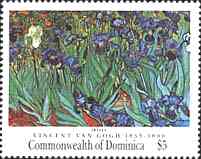 |
||
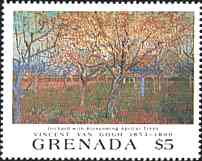 |
||
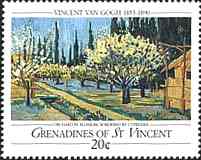 |
||
At the end of April 1889, fearful of losing his renewed capacity for work, which he regarded as a guarantee of his sanity, he asked to be temporarily shut up in the asylum at Saint-Rémy-de-Provence in order to be under medical supervision.
Van Gogh stayed there for 12 months, haunted by recurrent attacks, alternating between moods of calm and despair, and working intermittently: "Garden of the Asylum," "Cypresses," "Olive Trees," "Les Alpilles," portraits of doctors, and interpretations of paintings by Rembrandt, Delacroix, and Millet all date from this period.
After: Britannica
on-line.
Background: Blossoming Almond Tree